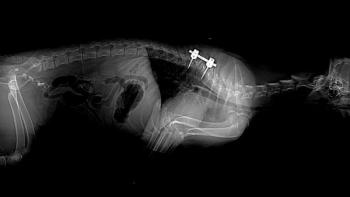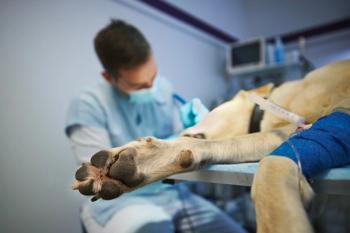
- dvm360 July 2020
- Volume 51
- Issue 7
Managing intervertebral disk disease: Do steroids have a place?
Recommendations for medical management of IVDD have changed, and corticosteroids are once again in the spotlight.
kintarapong/stock.adobe.com
“I am a veterinarian, and I love steroids,” Simon Platt, BVM&S, FRCVS, DACVIM, DECVN, confessed at the opening of his lecture on management of intervertebral disk disease (IVDD) at the 2018 Fetch San Diego conference. Although he acknowledged that corticosteroid use is controversial, Dr. Platt believes they have a place when used appropriately.
Diagnosing IVDD
In many cases, a presumptive diagnosis of IVDD can be made based on history and neurologic examination. For a chondrodysplastic patient presenting with acute-onset paraparesis or paraplegia and back pain, IVDD is the top differential. In other breeds with similar presentations, IVDD should still be on the list, along with trauma, inflammation, infection and neoplasia.
Patients presenting with clinical signs of IVDD can be divided into five grades based on the results of neurologic examination:
- Grade 1: Back pain without motor impairment
- Grade 2: Ambulatory paraparesis
- Grade 3: Nonambulatory paraparesis
- Grade 4: Paraplegia with pain perception
- Grade 5: Paraplegia without deep pain perception
Plain radiographs are not always useful, Dr. Platt noted, as the correct disk space is identified only 60% of the time. He reminded the audience that all chondrodysplastic dogs have disk disease; it's just a matter of whether the animal is symptomatic. Thus, plain radiographs in these patients are highly likely to indicate disk disease, but the correct space may not be identified. Radiographs are more useful in nonchondrodysplastic breeds to rule out other differentials.
Advanced imaging is needed to confirm the diagnosis and localize the lesion to make a surgical plan. Computed tomography (CT) and magnetic resonance imaging (MRI) are equally accurate in localizing the lesion, but CT scans are faster and more affordable for clients. Dr. Platt stated that some clinicians prefer MRI as it allows them to visualize edema in the spinal cord that cannot be viewed on CT, but this knowedge ultimately does not change the treatment plan.
Decision making: medical or surgical management?
Two treatment options exist for patients with IVDD, Dr. Platt said: conservative medical management and surgery. Determining what's best for the dog “comes down to neurologic status and how much money the owners have,” he stated.
Dr. Platt emphasized that successful treatment does not always mean a return to normal function. Clients must understand that treatment of IVDD is considered successful when patients are pain-free, can ambulate without assistance and maintain urinary and fecal continence.
Neurologic grade at presentation is most important in determining the success of both medical and surgical management:
- Grades 1 and 2: 90% success with both medical and surgical management
- Grade 3: 70% success with medical management vs. 90% with surgical management
- Grade 4: 50% success with medical management vs. 80% to 90% with surgical management
- Grade 5: Less than 5% success with medical management vs. 50% to 60% with surgical management within 24 to 48 hours of disease onset.
For patients with grade 5 disease that are managed surgically, the prognosis begins to decrease 48 hours after disease onset. By seven days after disease onset, the chance of recovery is minimal.
When comparing prognosis between medical and surgical management, it's obvious that patients presenting with grade 4 or 5 disease should undergo further workup and surgery when owner finances permit.
Given the comparable success rate in low-grade disease, Dr. Platt acknowledged that many practitioners may wonder why surgical treatment would be considered. He recommends the following criteria for surgical therapy:
- Paralysis at presentation (grade 4 or 5 disease)
- Patients that remain painful after seven days of medical management
- Patients that worsen neurologically during medical therapy
- Patients with recurrent back pain, which may be worse than initial presentation. Fifty percent of dogs presenting with back pain will have recurrence of clinical signs.
Principles of medical management
For patients managed conservatively, rest and pain control are the core of therapy. It's important for owners to understand the importance of rest in patient recovery. Cage rest should be continued for four to six weeks to give the disk space(s) time to heal. Dr. Platt noted that the length of time of cage rest can vary with the type of underlying disk disease.
Multimodal pain control is the other essential component of medical management. Either a nonsteroidal anti-inflammatory drug (NSAID) or low-dose corticosteroid should be used to address inflammation. Other pharmaceutical options for pain control include opioids, gabapentin and muscle relaxants such as diazepam or methocarbamol, which Dr. Platt feels are “vastly underutilized” for treatment of back pain. Nonpharmaceutical options such as acupuncture, hydrotherapy, laser therapy and physical rehabilitation can also be considered.
Inflammation and pain should resolve within several days of spinal injury. In patients with refractory pain after seven days of treatment or worsening disease in the face of medical management, surgical therapy is recommended.
The case for corticosteroids
“These days, I have a bit of an issue saying we shouldn't use steroids,” Dr. Platt said when discussing the choice of anti-inflammatory. He acknowledged the controversial history of corticosteroids in medical management of IVDD; studies in human and veterinary medicine have led to the conclusion that high-dose intravenous corticosteroids are contraindicated in acute spinal trauma in dogs, which has led to the belief that corticosteroids should never be used in spinal disease. “But that's wrong,” Dr. Platt said, “because you have inflammation in the spinal cord, and you often are not … in the acute stage.”
Dr. Platt pointed out that in animals it's difficult to know the exact timing of lesion onset. Inflammation is present, and corticosteroids are great at reducing inflammation. Because of this, Dr. Platt suggested that these drugs can be a powerful tool in the medical management of IVDD when used appropriately. He defined appropriate use as anti-inflammatory doses (0.5-1 mg/kg/day) for a short period of time. He does not recommend high-dose corticosteroids or their use in acute spinal injury.
In addition to being highly effective as an anti-inflammatory agent, corticosteroids are superior to NSAIDs with spinal analgesia, Dr. Platt said. NSAIDs don't do well with “chronic, severe compression of the spinal cord or the nerves.” Dr. Platt also noted that low-dose corticosteroids should not affect a patient's ability to undergo surgery if needed.
Take-home message
Medical management is highly successful for many patients with low-grade IVDD. In these patients, a combination of rest and pain control are essential to a successful outcome. Due to their anti-inflammatory properties, the use of short-term, low-dose corticosteroids can improve patient comfort and should be considered. In patients with paralysis, recurrent back pain, uncontrolled pain or worsening clinical signs despite medical management, surgery is the recommended course of action.
Dr. Kate Boatright, a 2013 graduate of the University of Pennsylvania, is an associate veterinarian in western Pennsylvania. She is actively involved in her state and local veterinary medical associations and is a former national officer of the Veterinary Business Management Association.
Articles in this issue
over 5 years ago
I like big blocks and I cannot lieover 5 years ago
Why are there so many different models for COVID-19?over 5 years ago
Vector-borne disease prevalence in dogs with proteinuriaover 5 years ago
Modulating the immune system to fight for goodover 5 years ago
FDA OKs cell therapy clinical trial for feline gingivostomatitisover 5 years ago
Hillbilly beardover 5 years ago
The right task at the right timeover 5 years ago
Can dogs be used to screen for COVID-19?over 5 years ago
Can pandemic rules be broken?over 5 years ago
What at-will employment means for veterinariansNewsletter
From exam room tips to practice management insights, get trusted veterinary news delivered straight to your inbox—subscribe to dvm360.





